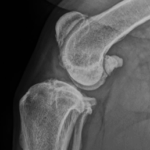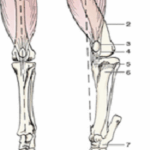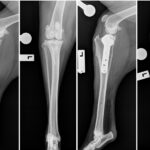
Does your dog get ear infections, lick their paws, or get an itchy belly each spring or summer? Do they have a bad smell about them, or drive you mad scratching?
The most common cause of skin problems over spring and summer is a pollen allergy.
Unlike people who tend to get hay fever from pollen allergies, dogs tend to get skin problems. The classic areas to be affected are the ears, paws, belly and armpits.
We used to think that pollen allergies worked systemically. That is, the pollen would be inhaled, get absorbed into the blood stream, then cause problems in the skin. We now believe the pollens cause issues directly by simply landing on the skin. This would explain why the areas most commonly affected are the hairless areas of the body.
When it comes to managing this sort of problem, we tend to look at it much like an asthmatic would look at their condition: treating the flare-ups and longer term control.
Treating the flare-ups
We quite often see secondary infections with these skin cases. Because the pollen allergy creates heat and moisture in the skin, the perfect environment for yeast and bacteria is produced. It is important to treat this infection, as this is often where a lot of the itchiness comes from. We may use medicated shampoos or antibiotics to do this.
We also need to settle down the itching. Traditionally we have used steroids to reduce the itching. In most cases, these drugs are well tolerated and very effective, though occasionally we would see some side-effects. We now have a completely new medication available which is very effective at reducing the itchiness quickly (around 4 hours) and avoids many of the side effects associated with steroids. We would recommend you ask your vet about this new treatment.
Longer term control
Ideally, we want to avoid the flare-ups as much as possible. This is often started as the same time as we treat a flare-up as many of the treatments can take some time to help.
It is important to control fleas and anything else which may contribute to skin irritation. We recommend a product called Bravecto, as it covers your dog for 3 months and can’t be washed off.
We need to improve the oils in the skin. We find most dogs with allergic skin disease have a defective oil barrier in the skin. This means more pollen contacts directly with the skin, which make the problem worse. We do this by using a zinc and fatty acid supplement, which is added to your dogs food on a daily basis.
Weekly bathing is also recommended. Depending on your dogs skin condition, it may be a medicated shampoo or we may recommend an oatmeal based shampoo. This helps control infection in your dog’s skin as well as washing away any pollen particles. We recommend following up with an oatmeal based conditioner, which is not rinsed off. A product such as PAW Nutriderm works well in most cases.
Antihistamines may also be useful in some cases. We find they are pretty hit and miss, with each antihistamine working in around 30% of cases. Talk to your vet about which antihistamines are worth trying for your dog.
Desensitisation can also be used in some cases. Testing is done to determine which pollens your dog is allergic to, then a series of injections are given containing very small amounts of the allergen. Over time, your dog’s immune system gets used to the pollen and stops overreacting.
To develop a treatment and management plan normally requires several visits. We will initially control and flare-ups and start some longer term management, then fine-tune things as we see the response.
Skin conditions can be frustrating to manage, but by working closely with your vet you’ll find a lot can be done to keep your pet comfortable.




Trackbacks/Pingbacks